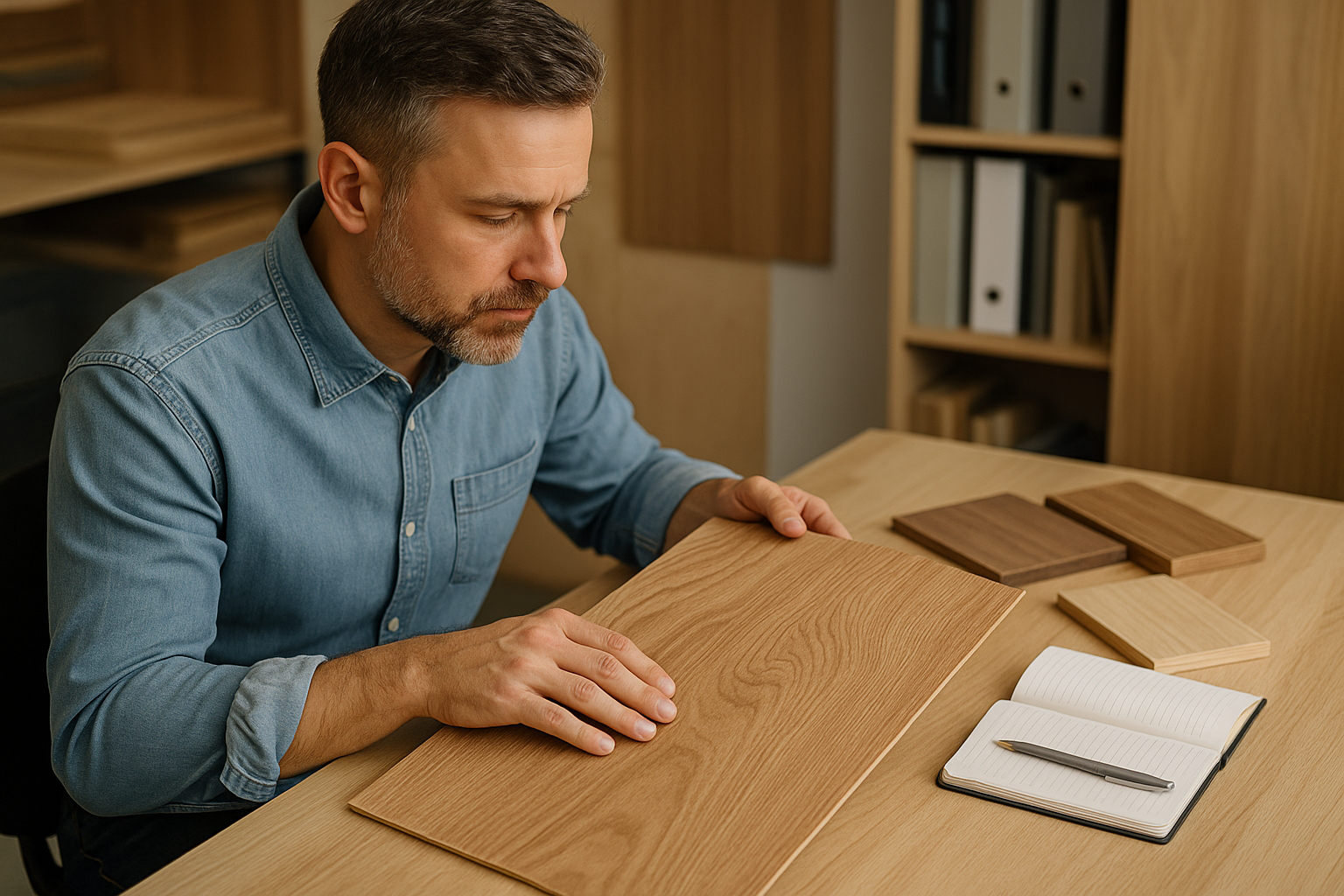What is Timber Veneer?
Timber veneer is a thin slice of real wood, usually between 0.3mm and 2.5mm thick, bonded to a substrate like MDF, plywood, or particleboard. It offers the visual appeal of solid timber while using a fraction of the material, making it both cost-effective and sustainable.
But what truly sets one veneer apart from another is the grain.
What is Wood Grain?
Wood grain refers to the alignment, texture, and appearance of wood fibres, essentially, a tree’s growth history made visible. Each line, swirl, or ring you see is shaped by environmental factors like rainfall, temperature, and soil quality.
Grain is influenced by:
- Tree species (e.g., oak, ash, walnut)
- Growth conditions (climate, soil, water access)
- Sawing technique (how the log is sliced)
These factors create a wide spectrum of patterns and textures, no two pieces are ever truly identical.
How Grain Patterns Are Formed
The grain structure is created by the tree’s annual growth rings. Each year, a tree produces:
- Earlywood (spring): Lighter-coloured, fast-growing cells with low density
- Latewood (summer): Darker, denser cells with slower growth
This layering forms the signature ring patterns we associate with timber. Variations in growth speed, climate, and log positioning during cutting result in distinct grain patterns, each suited to different design styles.
Common Grain Cuts and Their Visual Effects
The way a log is sliced plays a huge role in the final grain appearance. Here are the most common veneer cuts:
Quarter Cut
- Sliced at 90° to the growth rings
- Produces straight, uniform grain lines
- Ideal for minimalist, high-consistency interiors
- Common in: Oak, Teak, Blackbutt
Crown Cut (Flat Cut)
- Sliced along the log’s widest face
- Creates flowing “cathedral” or flame patterns
- Adds drama and movement to traditional or luxury designs
Rotary Cut
- Log is peeled like a roll of paper
- Bold, irregular grain pattern with wide swirls
- Used in plywood and large-volume commercial applications
Natural vs. Reconstructed Veneers
Natural veneers come directly from sliced logs, showcasing each tree’s unique grain. Perfect for projects where character, variation, and authenticity are essential.
Reconstructed veneers are engineered from fast-growing timbers and dyed to mimic the grain of exotic species like Ebony or Rosewood. They offer:
- Greater visual consistency
- Lower environmental impact
- Better scalability for large projects
- Ideal for retail chains, hotel fit-outs, and volume-based builds.
Texture: Beyond the Visual
Timber veneer doesn’t just look good, it feels good too. Texture plays a critical role in how we experience space and surfaces. Depending on the finish, texture can enhance grain, add depth, or invite tactile interaction.
Popular Veneer Textures:
- Smooth Sanded: Clean, soft feel for minimal, modern spaces
- Wire-Brushed: Emphasises natural ridges and valleys in the grain
- Rough-Sawn: Raw, industrial appearance with a handcrafted edge
- Embossed: Patterns are pressed into the surface for a 3D effect, great for feature panels or luxury fit-outs
Texture selection also influences how light reflects across a surface, making it an important design element
Matching Grain Patterns for Visual Consistency
In cabinetry, wall panelling, and architectural joinery, grain matching enhances flow and coherence.
Three primary methods include:
- Book Matching
Alternating veneer leaves are flipped like pages in a book to create symmetrical, mirror-like grain patterns. Ideal for feature walls and high-impact cabinetry. - Slip Matching
Sheets are laid in sequence without flipping, producing a uniform, continuous grain. Favoured for clean, contemporary aesthetics.
Random Matching Veneer sheets are mixed and unmatched, creating a casual, rustic vibe. Often used in industrial or organic interior styles.
Choosing the Right Grain and Texture
Before selecting a veneer, ask:
- How much variation is desirable?
Go with quarter cut for consistency; crown or rotary cut for visual drama. - Will the surface be touched often?
Smooth textures are easier to maintain in high-contact zones like cabinetry or doors. - Is sustainability a priority?
Choose FSC®-certified or reconstituted veneer options to minimise environmental impact.
Is light interaction important? Use brushed or embossed textures to control reflection and depth.
A Material That’s As Smart As It Looks
Thanks to its thin profile, timber veneer delivers up to 40x more surface area than solid timber from the same log. This makes it one of the most efficient and sustainable ways to use natural wood, especially in large-scale projects like commercial fit-outs, hotel interiors, and multi-residential developments.
And with today's technology, it’s easier than ever to:
- Source veneer digitally using high-res flitch scans
- Preview grain layouts in 3D before production
- Customise species, cuts, and finishes to suit project-specific goals
Final Thoughts: Design with Grain, Think with Purpose
Timber veneer is where natural storytelling meets modern design. The grain is more than just a visual, it’s a record of the tree’s life, shaped by science and refined by craftsmanship.
By understanding how grain forms, how it's cut, and how textures alter the feel and look, you can make informed design choices that are not only beautiful but also functional and environmentally responsible.
Explore premium timber veneers and grain-matched panel solutions at Bord Products, or contact our team for project-specific recommendations. For further guidance, visit our resources hub.

Explore Bord Products
Our Melbourne facility produces hundreds of veneer and laminate panels daily, giving us total control over timeframes and quality.

Visit Our Showroom
Get expert advice on material selection for your project and see our entire range of veneers and laminates in person.

Specify Sustainable
We support sustainable forest management in Australia and across the globe. Look out for certified products on our website or speak to us.




